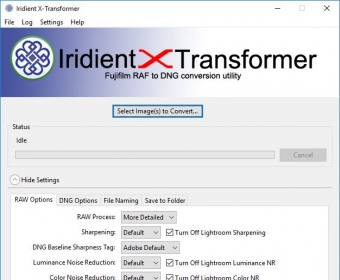
- IRIDIENT X TRANSFORMER FUJIFILM PROFILES HOW TO
- IRIDIENT X TRANSFORMER FUJIFILM PROFILES UPDATE
- IRIDIENT X TRANSFORMER FUJIFILM PROFILES SOFTWARE
- IRIDIENT X TRANSFORMER FUJIFILM PROFILES TRIAL
- IRIDIENT X TRANSFORMER FUJIFILM PROFILES SERIES
If not, no problem you didn’t spend any money and now you know the grass isn’t any greener on the Iridient hill… so to speak.
IRIDIENT X TRANSFORMER FUJIFILM PROFILES SOFTWARE
If you do, great the software itself is very affordable considering the time and headache it can save you.
IRIDIENT X TRANSFORMER FUJIFILM PROFILES TRIAL
The best part is, there is a free trial so you can test the program out to see if you notice any improvements/benefits in your workflow. If you are a Fujifilm shooter who has been wondering if there was an easier way to process your files or to help Lightroom run more smoothly when processing your Fujifilm images, then this could be something you want to try.

IRIDIENT X TRANSFORMER FUJIFILM PROFILES UPDATE
IRIDIENT X TRANSFORMER FUJIFILM PROFILES SERIES
This yielded excellent image quality and processing results from Fujifilm X Series cameras while maintaining our lightning-fast decoding speed. Our user feedback has been tremendous in helping our engineers solve both of these issues. Here is the overview of the image, the area is magnified below for comparison we show. The hardness of these edges must adapt to the strength of detail in the photo so they are strong on hard edges but soft in areas that are out of focus. These are often caused by internal masks used in raw processors to define different tonal ranges. Here are the processing results in that area using ON1 Photo 2017.0.2 and two other raw processors.Īnother processing issue we saw was the odd edges and artifacts in the bokeh, or out of focus regions in certain photos. Here is the overview of the image, the area in red is magnified below for comparison we show below. You can read more about Joel’s thoughts on Fujifilm X-Trans processing in his recent blog post. Here is a great example of this from Joel Wolfson, a respected photographer and writer.

IRIDIENT X TRANSFORMER FUJIFILM PROFILES HOW TO
Luckily for us we already knew the causes and how to properly solve the problem.

Years ago our Genuine Fractals users would get the same smeared look when upsizing their images. This issue was very familiar to us, but in a somewhat different use case. A common refrain we heard was other raw processors often created a smeared or painterly look in areas of texture like grass, bark and rock. When we first started this work we listened to our Fuji users and reviewed the processing results other tools in the market produced. For most cameras there has been years of research to optimize these algorithms for speed, quality and reduced errors (noise). These approaches don’t translate directly to the X-Trans layout which forced our engineers to develop a new and unique algorithm for Fujifilm X Series cameras. Here is what that looks like.įrom a software developers prospective, the way you interpolate, or debayer the raw data from these cameras is quite different from the algorithms we use for most other cameras. They also claim this layout provides for better color reproduction with less color noise. Fujifilm claims this filter layout reduces moire patterns naturally so you don’t need an anti-aliasing filter which can soften details in your photos. These sensors use a unique color filter pattern compared the the traditional Bayer pattern that most cameras use. Some of you out there shoot with Fujifilm® X series cameras that use the X-Trans® CMOS sensor.


 0 kommentar(er)
0 kommentar(er)
